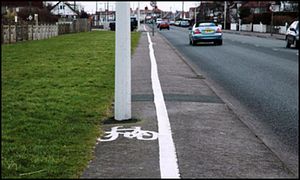|
By accessing or using The Crittenden Automotive Library™/CarsAndRacingStuff.com, you signify your agreement with the Terms of Use on our Legal Information page. Our Privacy Policy is also available there. |

The Greening Of Alternative Transport.
|
|---|
|
|
The Greening Of Alternative Transport.
Geoff Maxted
DriveWrite
January 3, 2014
Have you ever had your views consulted by any Government Department? The answer to that question from virtually everybody is ‘No’. Yet according to the Department for Transport (DfT) efforts to make it easier for people to choose greener ways of travelling to and from public transport hubs are working, at least according to a new report. Wonder who they are asking? It certainly wasn’t DriveWrite. Mind you, to be totally frank, they probably shouldn't ask me.
The so-called ‘door to door action plan’ published the other day by the DfT identifies the apparent good work being ‘taken forward’ that will help make door-to-door journeys by public transport, cycling or walking the norm. Real life journeys on public transport tend to be more complicated than just a single trip on a train or three stops on the local bus. The Government say they want to make it as easy as possible for people to choose greener ways of getting between each mode of transport.
Since they launched this ‘door to door strategy’ eight months ago, there have apparently already been significant improvements to integrate public transport. This action plan highlights where progress has been made but there is still more to be done.
Quoted examples of successes include a £14 million investment in two new state-of-the-art bus interchanges at Rochdale and Mansfield improving integration with rail as well as making it easier and safer for people to use sustainable transport. Additionally, a £14.5 million investment in cycle facilities at railway stations has been the major enabler in doubling the amount of cycle parking spaces at stations in the lifetime of this Parliament. This has contributed to the number of cycle-rail journeys increasing from 14 million in 2009 to an all time high of 39 million a year.
Last summer the Prime Minister announced plans for ‘cycle-proofing’ roads so that all new trunk roads and improvement schemes will be designed with cyclists as well as motorists in mind. As part of that, the Highways Agency is also spending £20 million to improve existing infrastructure for cyclists on the strategic roads network. Perhaps we’ll finally see an end to the pathetic piecemeal approach that gives cyclists ridiculously short sections of safety before plunging them back into the traffic.
All these plans are all very well and good but how many non-car users are truly receiving any form of benefit out of these grandiose pronouncements and patchwork improvements? Certainly nobody in rural areas that’s for sure. Until this country has a root and branch look at its transport infrastructure there will always be winners and losers. Statistics can say anything we want them to say.



















